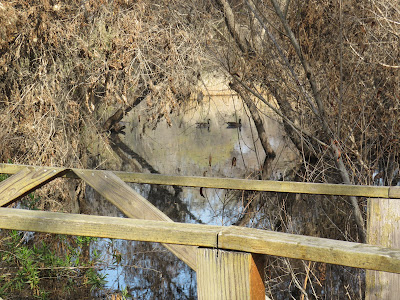The mid-morning weather is pleasant for Caroline and me to hike, once again, in Torrance California’s 43-acre Madrona Marsh Preserve where a 10-ft high fence separates this limited access nature oasis from an urban setting of major human commotion. Following a perimeter path, I pause to watch a Honeybee feeding on a Pacific Willow flower and then look out on the pond to see a Wigeon duck. Still scanning the pond, a family of Northern Shovelers catch my attention while on shore, I hear the land call of a Pacific Tree Frog (stock photo). Further ahead, I spot two birds that would not be seen in Michigan, a Say’s Phoebe and a Black Phoebe. The Black Phoebe is a small North American flycatcher found throughout California and Arizona. Some believe that this bird energizes the spirits of people by their swooping flight and high-pitched chirp. Their spiritual meaning, according to Native American mythology, like other species of blackbirds is death, change, magic, or mystery. Nearby, I come upon fresh mounds and holes made by nocturnal Valley Pocket Moles (stock photo). The pocket in their name refers to two fur-lined cheek pouches used for carrying food and nest materials. These pockets open outside the mouth, can extend back to the shoulders, and can be turned inside out for emptying. Sometimes nicknamed “Nature’s rototillers”, their constant burrowing helps keep soil loosened and aerated, while burying vegetation that enriches the soil. Continuing around the perimeter, I observe yellow blossoms of Common Deerweed at my feet and a perching Lesser Goldfinch overhead. Further along, I stop to listen to the lovely song of a perching White-crowned Sparrow accompanied by traffic noise. Nearby, I watch a colorful, perching Allen’s Hummingbird fluttering its wings. Approaching the trailhead, I come upon a huge Eucalyptus tree. Moving closer, I notice a bee feeding on one of the blossoms. Eucalyptus is a fast-growing, invasive, evergreen tree native to Australia. The leaves are dried, crushed, and distilled to release oil that is used to reduce symptoms of coughs, colds, and congestion. It’s also used in ointments aimed at relieving muscle and joint pain, in antiseptics, perfumes, cosmetics, flavorings, dental preparations and industrial solvents.
Island of nature
Turbulent seas
Sound waves crash
Buzzing of bees
Oasis of nature
Tons of tar
Floating Mallards
Speeding car
Refuge of nature
Away from the din
Madhouse without
Sanctuary within
D. DeGraaf




